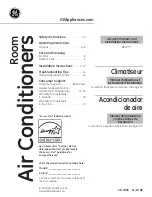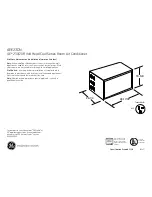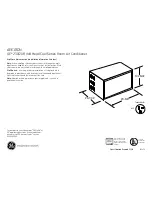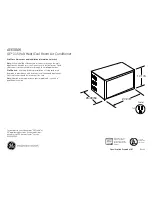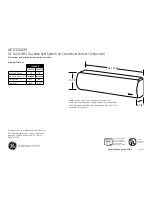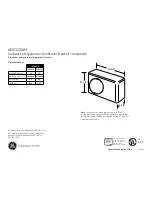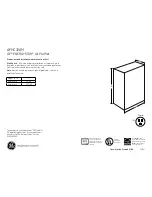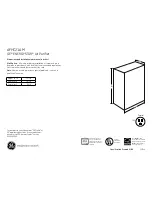
60
Service & Maintenance (Continued)
[ ] YC* units only - Check the heat exchanger(s) for any cor-
rosion, cracks, or holes.
[ ] Check the combustion air blower for dirt. Clean as neces-
sary.
WARNING
Hazardous Gases and Flammable Vapors!
Exposure to hazardous gases from fuel substances
have been shown to cause cancer, birth defects or other
reproductive harm. Improper installation, adjustment, al-
teration, service or use of this product could cause flam-
mable mixtures. To avoid hazardous gases and flam-
mable vapors follow proper installation and set up of
this product and all warnings as provided in this
manual. Failure to follow all instructions could result in
death or serious injury.
When using dry nitrogen cylinders for pressurizing units
for leak testing, always provide a pressure regulator on
the cylinder to prevent excessively high unit pressures.
Never pressurize unit above the maximum recom-
mended unit test pressure as specified in applicable unit
literature. Failure to properly regulate pressure could re-
sult in a violent explosion, which could result in death or
serious injury or equipment or property-only-damage.
[ ] Open the main gas valve and apply power to the unit heat-
ing section; then initiate a "Heat" test using the start-up
procedure described in "Verifying Proper Heater Opera-
tion".
[ ] Verify that the ignition system operates properly.
Note: Typically, it is not necessary to clean the gas
furnace. However, if cleaning does become
necessary, remove the burner plate from the front of
the heat exchanger to access the drum. Be sure to
replace the existing gaskets with new ones before
reinstalling the burner.
Table 27
Grease Recommendations
Recommended
Recommended Grease
Operating Range
Exxon Unirex #2
Mobil 532
-20 F to 250 F
Mobil SHC #220
Texaco Premium RB
Coil Cleaning
Regular coil maintenance, including annual cleaning—en-
hances the unit’s operating efficiency by minimizing:
compressor head pressure and amperage draw;
water carryover;
fan brake horsepower; and,
static pressure losses.
At least once each year—or more often if the unit is located
in a “dirty” environment—clean the evaporator and con-
denser coils using the instructions outlined below. Be sure to
follow these instructions as closely as possible to avoid dam-
aging the coils.
[ ] Generally inspect the unit for unusual conditions (e.g.,
loose access panels, leaking piping connections, etc.)
Make sure that all retaining screws are reinstalled in the
unit access panels once these checks are complete.
With the unit running, check and record the:
ambient temperature;
compressor oil level (each circuit);
compressor suction and discharge pressures
(each circuit);
superheat and subcooling (each circuit);
Record this data on an “operator’s maintenance log” like the
one shown in Table 28. If operating pressures indicate a re-
frigerant shortage, measure the system superheat and sys-
tem subcooling. For guidelines, refer to "Charging by Sub-
cooling".
Note: Do Not release refrigerant to the atmosphere!
If adding or removing refrigerant is required, the
service technician must comply with all federal,
state and local laws. Refer to general service
bulletin MSCU-SB-1 (latest edition).
Heating Season
Before completing the following checks, turn the unit OFF
and lock the main power disconnect switch open.
WARNING
Hazardous Voltage!
Disconnect all electric power, including remote discon-
nects before servicing. Follow proper lockout/tagout
procedures to ensure the power can not be inadvertently
energized. Failure to disconnect power before servicing
could result in death or serious injury.
[ ] Inspect the unit’s air filters. If necessary, clean or replace
them.
[ ] Check supply fan motor bearings; repair or replace the
motor as necessary.
[ ] Check the fan shaft bearings for wear. Replace the bear-
ings as necessary. These bearing are considered perma-
nently lubricated for normal operation. For severe dirty ap-
plications, if relubrication becomes necessary, use a
lithium based grease. See Table 27 for recommended
greases.
Note: The bearings are manufactured using a
special synthetic lithium based grease designed for
long life and minimum relube intervals. Too much
lubrication in a bearing can be just as harmful as
not enough.
Use a hand grease gun to lubricate the bearings; add
grease until a light bead appears all around the seal. Do
not over lubricate!
After greasing the bearings, check the setscrews to en-
sure that the shaft is held securely. Make sure that all
bearing braces are tight.
[ ] Inspect both the main unit control panel and heat section
control box for loose electrical components and terminal
connections, as well as damaged wire insulation. Make
any necessary repairs.
Summary of Contents for Voyager RT-SVX17C-EN
Page 8: ...8 Figure 1 Unit Dimensions for TC_ TE_ and YC_330 360 and 420 MBH Units Low Heat ...
Page 9: ...9 Figure 1 continued Unit Dimensions for YC_330 360 and 420 MBH Units High Heat ...
Page 10: ...10 Figure 1 continued Unit Dimensions for TC_ TE_ and YC_480 and 600 MBH Units Low High Heat ...
Page 24: ...24 Figure 10 Typical FieldWiring Requirements for CV Control Options ...
Page 78: ......
Page 79: ......
Page 80: ......


































